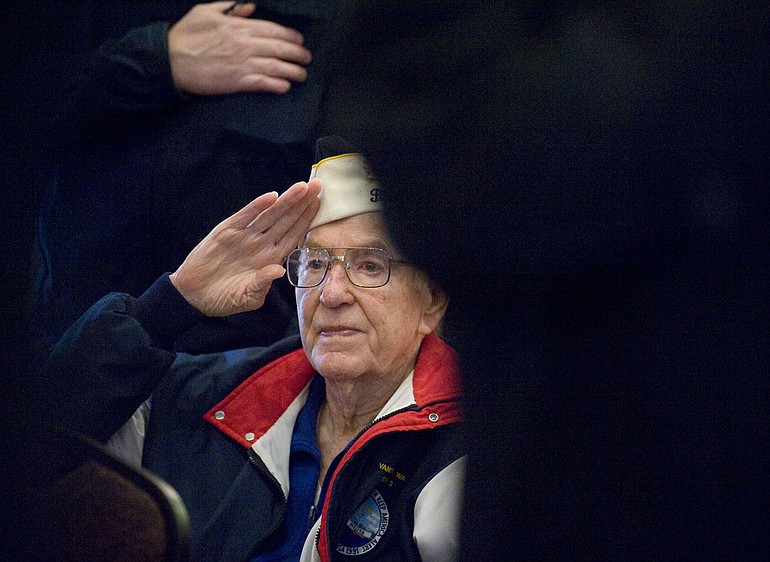Rich Hatton was headed to breakfast aboard the USS Worden when he saw all the fancy flying going on in the sky over Pearl Harbor.
As Hatton saw planes swoop and dive and skim the water, “I couldn’t imagine what our Air Force was doing,” he said.
Then things started blowing up, and he saw the bright red balls on the wings of the planes.
“My God, those are Japanese planes,” Hatton realized.
Hal Lacey, who was part of the breakfast shift on the USS Tennessee, was heading topside so he could dump a pan of dishwater off the battleship.
“Guys were coming down the ladder,” Lacey said, and they told him the Japanese were attacking the American fleet.
“I put the dishwater down and headed to my battle station,” said Lacey, vice president of the Vancouver chapter of the Pearl Harbor Survivors Association.
They were among the Pearl Harbor veterans who gathered Tuesday to remember the 2,400 sailors, Marines and soldiers who died on Dec. 7, 1941.
The Vancouver chapter welcomed members of the Portland survivors’ chapter for the annual event, held for the first time at the E.B. Hamilton Hall on the Vancouver Barracks campus.
Gene Cole, president of the Portland chapter, was part of an aviation squadron based at Bellows Field. That was the scene of a unique meeting between American defenders and a Japanese attacker.
On the day after the attack, American forces captured a two-man miniature submarine that had grounded just off Bellows Field.
“It was right off the end of our runway,” Cole said. “We captured the officer. He wanted us to shoot him. We did not oblige.”
No, they had bigger targets in mind, Cole said.
“Our big objective was to get back into the fight and finish it,” Cole said.
Aboard the USS Worden, it didn’t take long to switch from defense to offense. Less than three hours after the attack had started, the destroyer was heading out of Pearl Harbor — with some emergency duty on the way out of the harbor.
“We pulled up survivors” out of the water, Hatton said. “We went to sea with 60 additional personnel.”
The Worden joined a cruiser and several other destroyers in the Pacific.
“We were searching for the Japanese fleet,” Hatton said. “Fortunately, we didn’t find them.”
Lacey, who was aboard the Tennessee at Pearl Harbor, served on three other battleships during 50 straight months of sea duty.
Lacey was on the USS West Virginia during the Battle of Surigao Strait, a historic part of the campaign to retake the Philippines.
“It was the last battle between battleships,” Lacey said. It truly was a battle of giants. His ship fired massive shells, 16 inches in diameter, that weighed almost 1½ tons each.
“We fired 93 rounds in 12 minutes,” Lacey said.
Cole spent the war with the 345th Bomber Group, where he got to play a special role in its conclusion.
Cole was part of a B-25 bomber crew that supported island-hopping troops and attacked Japanese shipping. The “Air Apache” B-25s were equipped with more than a dozen .50-caliber machine guns that could just about dissolve the hull of an enemy ship.
Cole eventually got to participate in his long-range objective: to finish the war. He was a co-pilot on one of the two B-25 bombers that were part of the Japanese surrender process.
“My last mission on a B-25 was to escort a (Japanese) ‘Betty’ bomber carrying a peace ambassador back to Japan,” Cole said.
“It was a pleasant feeling,” Cole said. “That was what I was there for. To end it.”




